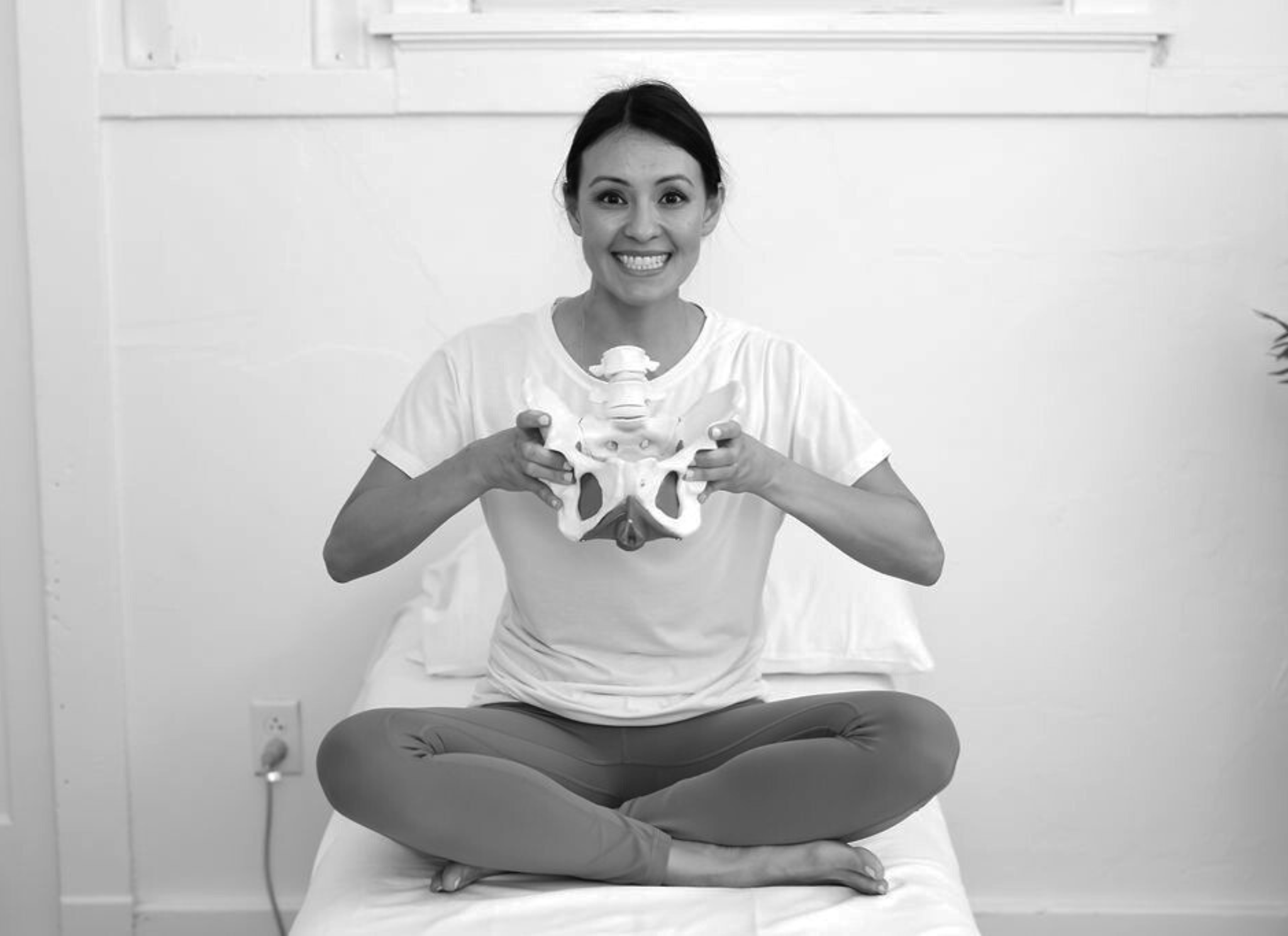Kegels. We all know the word. But do we really know what it actually MEANS to do a kegel (and, btw, what is a kegel weight?), and why do we even care? I will tell you. And believe me, I have a love/hate relationship with the kegel, which I will explain.
The invention of the kegel
We have Dr. Arnold Kegel to thank, back in 1948 for coming up with the famous “kegel” exercise. He was a gynecologist. He was looking for a non-surgical way for women to help “tone” the pelvic floor muscles. Dr. Kegel wanted to help women with urinary leaking after they had a baby. I don’t hate him for it.
Being a physical therapist, I want all things conservative first. YAY for starting with exercise. Good on ya, Dr. Kegel (the kegel weight came later)!
The blanket approach
This opened up a new view on trying to help women after childbirth with staying dry. This is a step forward. The ever-challenging path of providing comprehensive care postpartum is ongoing. Which I am sad to say, leaves something to desire in this country… more on that in another blog post.
Kegel’s became the blanket approach for EVERYONE. If you had bladder, bowel or pelvic dysfunction, it was a kegel for you. Pain with sex? Kegel. Urinary incontinence? Kegel. Having increased urge and going to the bathroom all the time? Kegel. Back pain? Kegel. Pregnant? Kegel FOR SURE. Want a tight vagina (cringing as I’m typing this)? Kegel. And the list goes on….
Kegels are not the answer to everything. They are appropriate for some people. They are not appropriate for all. Mind blown. I know. Stay with me.
What is a kegel?
A kegel is a concentric, or shortening action, of the pelvic floor muscles, which sit at the bottom of your pelvis. They lie like a basket, or a hammock, and attach front to back (pubic bone to tailbone) and side to side (sit bone to sit bone). Within these muscles, we find openings. In females, we have the rectum, the vagina, and the urethra. In men, we have the rectum, and the urethra. The urethra follows the length of the penis and is past the pelvic floor, where it ends at the tip of the penis.
The pelvic floor has 3 main functions:
- Support: holds us and our organs up against gravity.
- Sexual: aids in orgasm and allowing vaginal penetration for women.
- Continence: keeps us dry.
How all this works
In a perfect world, as the bladder and rectum are filling with urine and stool, the pelvic floor muscles “turn on.” They do this to close the sphincters that hold in the urine and stool. We get the signal to either head to the loo to pee or grab our phones for if we are going in for a longer stretch.
The pelvic floor muscles lengthen, or relax, and the bladder (the detrusor) pushes urine out. It does this through an open urethra, all thanks to a relaxed and lengthened pelvic floor.
Have you ever experienced difficulty with bladder control? Difficulty with bowel movements? Noticed a decrease in sexual sensitivity? These could be symptoms of a weak pelvic floor. So, yes, you made need to do kegels. Luckily, a kegel weight or a trainer (also known as vaginal weights or kegel bals) can help strengthen these muscles effectively. Let’s continue.
How to check if you’re doing a kegel correctly
To check if you’re contracting and relaxing your pelvic floor correctly, do an internal exam. This is similar to what a pelvic floor PT would check in person.
- Lie down on your back or side (or stand in the shower if it’s more convenient).
- Insert a clean finger to your first knuckle near “6 p.m. position.” Meaning if the vagina opening was a clock, noon is toward the urethra and clitoris, 6 p.m. is toward the anus and tailbone.
- From this depth, check your ability to kegel. Try to contract and relax and see if you can feel a close (contract) and open (relax).
- Next, enter further into the vagina and hook your finger onto a side – usually towards “3:00” or “9:00” position. You should feel your finger resting on a ledge (the pelvic floor being like a bowl).
- In the 3:00 and later in the 9:00 position, check your ability to kegel. Can you feel your finger gently pulling up and in with the contraction? That’s a good sign! Can you feel yourself relax your muscles fully after your kegel? That’s also a good sign!
Don’t feel anything at all? Barely feel a lifting/pulling your finger in with your contraction? Feel yourself pushing your finger out? It’s a good idea to follow up with a pelvic floor PT for further feedback and instruction.
When should I kegel?
Have your pelvic organs and vaginal muscles lost strength? This can happen during pregnancy. Not to mention the force of actually pushing a baby out. Yes, if you’ve given birth you may see a bit of an issue with holding in urine, or stool. This is especially true if there was any perineal or pelvic floor muscle trauma. Pelvic organ prolapse sustained during delivery can contribute as well.
So yes, in this case, it is a good idea, probably, to strengthen your pelvic floor by way of the kegel.
When should I not kegel?
It’s important to note that in some cases, these muscles can be too short, or too contracted. This means adding more contractions on top of an already contracted, or too short muscle, isn’t best. Think about trying to do a bicep curl when you’re already curled. The elbow isn’t going anywhere, and all that extra curling will prob make your bicep hurt!
My issue with kegels
Another issue I have with blindly prescribing kegels…and we’ve all heard this: “Just do 200 kegels a day” or “ do your kegels while sitting at a stop light”… is that not everyone’s baseline level of strength and function is the same. Also, we don’t go to the gym and do 200 bicep curls everyday. We don’t walk around carrying a 35lb pound weight with our bicep all day every day…. (well…I mean…unless you’re a mom….). We shouldn’t be prescribing set parameters without assessing.
Some people may not need to do kegels. They may need to work on lengthening or volitionally dropping their pelvic floors. They may need other pelvic floor exercises (yes, they exist!). These muscles can be too short or tight. Oftentimes kegels can make your pelvic health symptoms and dysfunction worse.
What is a kegel weight?
But, if kegels are for you, you may be wondering what is a kegel weight or what is a kegel trainer? Kegel weights and trainers are devices to help exercise the pelvic floor muscles. They operate on the principle of resistance. This means that it becomes harder to contract the muscles. This should result in increased strength over time. Some are simple weighted balls inserted into the vagina. And some are devices that track muscle contraction strength and progress.
When to use a kegel weight?
Pregnancy, childbirth, aging, and obesity are some of the factors to consider. These can cause or exacerbate pelvic floor weakness. If you have incontinence, pain during sex, or constipation, seek medical advice. Even without symptoms, using kegel weights and trainers can help prevent future issues. This is true if you can do it right and it’s the right exercise for you.
Which kegel weights and trainers are the best fit for you?
When picking one consider your goals, level of experience, and budget. For beginners, it’s best to choose simple, body-safe weight options. Silicone or steel balls that come in varying weights can be an excellent starter option. We recommend the following. Always purchase ones that are high quality.
- The Intimate Rose system is BPA-free, medical grade, and doesn’t have openings or grooves that collect bacteria.
- Perifit is an innovative kegel trainer. It has a built-in sensor and feedback system that gives you real-time information on your progress and allows you to adjust the intensity of the exercise as needed.
- We also love the Elvie app-controlled kegel trainer.
How to use a kegel weight or trainers?
Before you insert kegel weights, make sure to clean them with warm water and antibacterial soap. It’s best to start with a light load and build up as you progress.
To use these weights and trainers, position them against the pelvic floor muscles and insert the weight. Think about squeezing or lifting them upward, like you are trying to stop the flow of urine. Hold the squeeze for about five seconds, then release for five seconds to relax the muscles.
Repeat this for 10 to 15 reps, and aim for three sets per day. Be sure to use heavier weights over time as your muscles strengthen.
Not sure? Ask for help!
Studies show that around 30% of women don’t contract their pelvic floor at their first consult. So the bottom line is this: if you’re not sure, ask for help. Find a pelvic floor PT to assess and get you on the right track.
Performing a kegel correctly is hard! The muscles have to work in concert with a host of other muscles. These also have to work your breath AND be on like all the time to keep us supported and continent. It’s not easy to get this contraction going right. I’ve had high level athletes who have crazy body awareness have a hard time getting a correct kegel.
So, there you go. Kegels are important, for sure, but in the right context, with the right person and situation. Find a local pelvic floor PT near you to help you get that pelvic floor muscle working the way it should. Remember, this could be either kegel’ing or lengthening.
___________________________________________________________________________________________
Interested in more tips on how to prevent or overcome Pelvic Floor Problems?
Download this free guide for some simple, do-able, totally-not-weird tips to take better care of your down there.
___________________________________________________________________________________________




